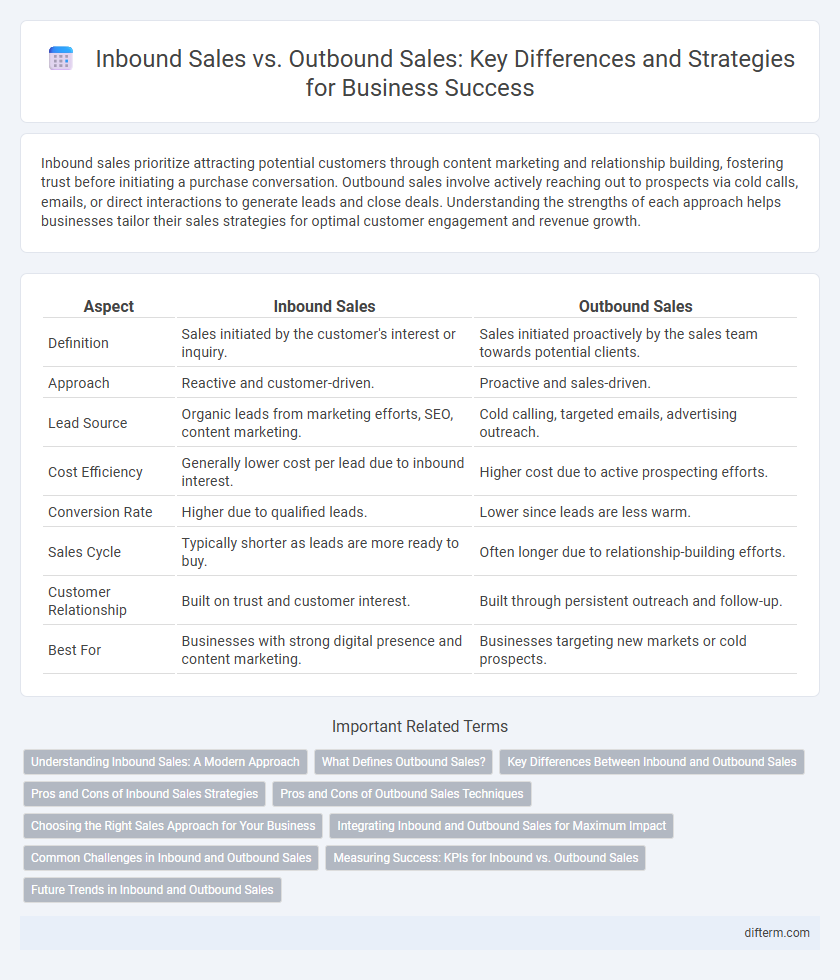Inbound sales prioritize attracting potential customers through content marketing and relationship building, fostering trust before initiating a purchase conversation. Outbound sales involve actively reaching out to prospects via cold calls, emails, or direct interactions to generate leads and close deals. Understanding the strengths of each approach helps businesses tailor their sales strategies for optimal customer engagement and revenue growth.
Table of Comparison
| Aspect | Inbound Sales | Outbound Sales |
|---|---|---|
| Definition | Sales initiated by the customer's interest or inquiry. | Sales initiated proactively by the sales team towards potential clients. |
| Approach | Reactive and customer-driven. | Proactive and sales-driven. |
| Lead Source | Organic leads from marketing efforts, SEO, content marketing. | Cold calling, targeted emails, advertising outreach. |
| Cost Efficiency | Generally lower cost per lead due to inbound interest. | Higher cost due to active prospecting efforts. |
| Conversion Rate | Higher due to qualified leads. | Lower since leads are less warm. |
| Sales Cycle | Typically shorter as leads are more ready to buy. | Often longer due to relationship-building efforts. |
| Customer Relationship | Built on trust and customer interest. | Built through persistent outreach and follow-up. |
| Best For | Businesses with strong digital presence and content marketing. | Businesses targeting new markets or cold prospects. |
Understanding Inbound Sales: A Modern Approach
Inbound sales leverage digital channels and content marketing to attract and engage potential customers who actively seek solutions. This approach prioritizes personalized interactions and data-driven insights to nurture leads through the buyer's journey. Emphasizing trust-building and value delivery, inbound sales align with contemporary buyer behavior by addressing needs proactively rather than relying on cold outreach.
What Defines Outbound Sales?
Outbound sales is defined by proactively reaching out to potential customers through direct methods like cold calling, email campaigns, and targeted advertisements. This approach relies on identifying and engaging leads who have not previously expressed interest in the product or service. Sales teams using outbound strategies focus on initiating contact to generate demand and accelerate the sales pipeline.
Key Differences Between Inbound and Outbound Sales
Inbound sales rely on attracting potential customers through content marketing, SEO, and social media engagement, allowing prospects to initiate the buying process. Outbound sales involve proactive outreach methods such as cold calling, email campaigns, and direct advertising to engage prospects. Key differences include the source of lead generation, with inbound focusing on earned interest and outbound on targeted outreach, impacting conversion strategies and sales cycle duration.
Pros and Cons of Inbound Sales Strategies
Inbound sales strategies leverage customer-driven interest through content marketing, SEO, and social media engagement, resulting in higher-quality leads and better conversion rates. However, inbound sales require significant upfront investment in content creation and demand sustained effort to maintain online visibility and attract prospective buyers. While inbound sales align with modern buyer behavior by fostering trust and long-term relationships, they may yield slower short-term results compared to outbound tactics.
Pros and Cons of Outbound Sales Techniques
Outbound sales techniques enable businesses to proactively reach potential clients through cold calls, emails, and direct messaging, accelerating lead generation and market penetration. However, these methods often face challenges such as higher rejection rates, increased costs per acquisition, and potential damage to brand reputation due to perceived intrusiveness. Despite these drawbacks, outbound sales remain effective for targeting specific demographics and quickly scaling sales efforts in competitive markets.
Choosing the Right Sales Approach for Your Business
Choosing the right sales approach depends on your business goals, target audience, and resources. Inbound sales capitalize on attracting warm leads through content marketing and SEO, making it ideal for businesses aiming for long-term customer relationships and higher conversion rates. Outbound sales involve proactive outreach like cold calls and emails, suitable for rapidly expanding market reach and acquiring quick sales results.
Integrating Inbound and Outbound Sales for Maximum Impact
Integrating inbound and outbound sales leverages the strengths of both strategies to maximize customer acquisition and retention. Inbound sales attract prospects through content and engagement, while outbound sales proactively reach targeted leads with personalized outreach. Combining these approaches creates a cohesive pipeline that enhances lead nurturing, improves conversion rates, and drives sustainable revenue growth.
Common Challenges in Inbound and Outbound Sales
Inbound and outbound sales both face common challenges such as lead quality and conversion rates. Inbound sales often struggle with managing high volumes of unqualified leads, while outbound sales encounter difficulties in reaching decision-makers and overcoming rejection. Sales teams must optimize targeting and messaging strategies to improve engagement and close rates across both approaches.
Measuring Success: KPIs for Inbound vs. Outbound Sales
Key performance indicators (KPIs) for measuring success in inbound sales include lead conversion rate, customer acquisition cost (CAC), and average deal size, reflecting how effectively incoming leads are nurtured and closed. Outbound sales KPIs prioritize metrics such as cold call success rate, outreach-to-meeting ratio, and sales cycle length to evaluate proactive prospecting and pipeline generation efficiency. Comparing these KPIs helps businesses tailor strategies by understanding the strengths and weaknesses of inbound versus outbound sales efforts.
Future Trends in Inbound and Outbound Sales
Future trends in inbound sales emphasize increased use of AI-driven personalization and automation to enhance customer engagement and lead qualification. Outbound sales are evolving with data analytics and AI-powered prospecting tools, enabling more precise targeting and efficient outreach efforts. Both strategies are converging towards a hybrid model leveraging technology to optimize sales funnels and improve conversion rates.
Inbound Sales vs Outbound Sales Infographic

 difterm.com
difterm.com